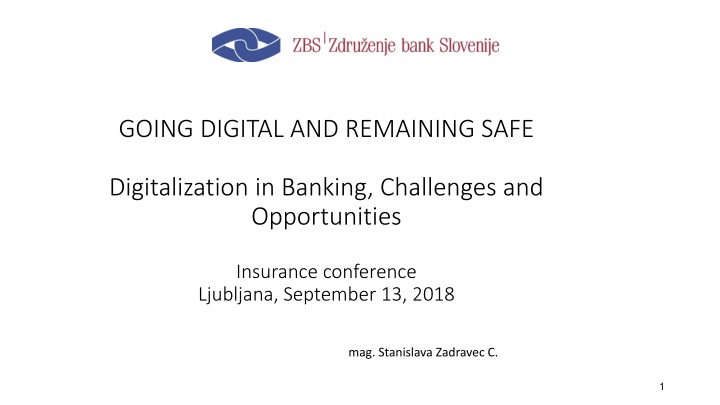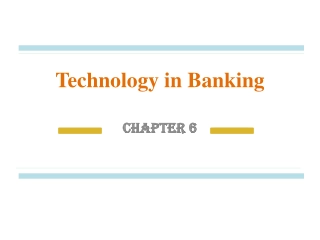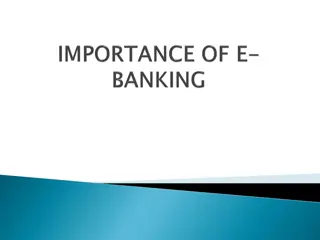
Digital Banking Challenges and Opportunities in Cybersecurity
Explore the impact of digitalization in banking, focusing on cybersecurity challenges and opportunities, regulatory changes, customer behavior shifts, payment advancements, and data protection risks. Learn about the evolving landscape in financial services and the demands for secure data management, consumer protection, and compliance with regulatory requirements.
Download Presentation

Please find below an Image/Link to download the presentation.
The content on the website is provided AS IS for your information and personal use only. It may not be sold, licensed, or shared on other websites without obtaining consent from the author. If you encounter any issues during the download, it is possible that the publisher has removed the file from their server.
You are allowed to download the files provided on this website for personal or commercial use, subject to the condition that they are used lawfully. All files are the property of their respective owners.
The content on the website is provided AS IS for your information and personal use only. It may not be sold, licensed, or shared on other websites without obtaining consent from the author.
E N D
Presentation Transcript
GOING DIGITAL AND REMAINING SAFE Digitalization in Banking, Challenges and Opportunities Insurance conference Ljubljana, September 13, 2018 mag. Stanislava Zadravec C. 1
Content Content Changes in the environmentnt and impact on the cybersecurity Digital skills and cybersecurity Conclusion/ Digital transformation priorities
Changes in the environmentnt and impact on the cybersecurity Significant regulatory changes Changes in the behaviour of customers Data abuse and data protection New alternative ways to access customers in relation with Digitalization in the area of financial services/products Business models that have to adopt to the digitalization area
Significant regulatory changes Since the financial crisis there have been significant changes: Increased transparency and reporting demand Demands on security and secure data management Demands on consumer protection Changes in the area of anti money laundering and terrorist financing
Changes in the behaviour of customers Are multilayer: Influence of new technologies on the customers behaviour expectations related to the provision of financial services (including cost) New technologies of transaction execution (mobile and other applications) Tolls for customers behaviour patterns data management Capacity to generate understanding of how the changes in patterns of behaviour affect the changes in customers needs
Especially payments execution has experienced fast development in last years customers using online and mobile payments
Data abuse and data protection One of most dynamic risks Fast development of technologies and ways for cyber attacks , especially customers data attacks, are becoming highly complex Customers data protection is urgent for maintaining the trust, which requires capacity for: Timely identification of risk of fraud Fast response to the risk of fraud Providing forecast analysis and Investment in to development Including also the risk of fulfilling increasing regulatory requirements
Uncertainties Role of identity impact of digitalization on the use of identify data in the financial sector Monetization of data how to increase revenues from available data? Technology management how to manage risk of fast technological development how to assure understanding ? Systemic transparency how increased demands impact existing business models?
Digital skills status in the EU and some cybersecurity facts 44% = 169 million Europeans do not have basic digital skills and 77 million out of those have no digital skills at all 37% = 93 million of the European labour force do not have basic digital skills 80% of European companies have experienced at least one cybersecurity incident There are approx. 4,000 ransomware attacks per day 95% of cyber incidents are enabled by some type of human error Source: EBF
Activities to enhance the digital skills of customers Safeguard the integrity of banking networks and the trust of customers Engage in partnerships with other institutions (police, Europol ) Raise awareness on cybersecurity and digital skills of different groups of population: Customers Children Elderly Professionals- financial sector employees Contribute to the process of shaping European regulatory and supervisory environment harmonization process in the area of the fight against the cybercrime
Conclusion/Digital transformation priorities Digital transformation of business models is one of the priorities and needs to be based on Regulation Cybersecurity (joint/shared platforms for risk identification and cooperation) Digital skills (constant education process) Access / E-identification / e-signature /e-archiving ( Electronic Commerce Act , Electronic Identity Management Act") Data (data analytics and privacy) (automatization /centralization?) Online platform and infrastructure Shared/joint platforms to manage/decrease cost of development/investment (B2B, B2C, data base management, data aggregation ) Partnership instead of competition






















